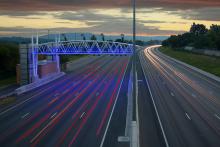
Satellite-based tolling opens up new options for authorities and can be integrated with DSRC systems as David Crawford discovers.
As the proud custodian of the European Union (EU)’s longest road network covered by a single (truck) charging scheme – and the only one to include all major roads - Slovakia has become the continent’s poster-nation for the virtues of GNSS/CN (Global Navigation Satellite System/Cellular Network)-based tolling. It is also proved to be a very fast implementer. Speaking at the 2014 ITS in Europe congress in Helsinki, Finland, Norbert Schindler, global sales manager of
The approach has enabled the Slovak national truck tolling scheme to expand from the original 2,447km to 7,762km within three months.
Slovakia introduced its scheme on 01 January 2010, after an 11-month implementation period, for all vehicles over 3.5tonnes – on motorways and first-class (trunk) roads. The country claims to have broken new ground by including non-motorway roads, in a bid to avoid problems experienced in other EU Member States where trucks have been able to divert from tolled sections without too great an inconvenience.
In Slovakia the trunk roads generated one-third of the scheme’s total revenues during the first three years of its operation, leading to the government’s decision to extend it.
The solution adopted also benefits from using the country’s existing infrastructure of GSM networks to enable data communication between OBUs and the back office for central services including registration and billing. Said Schindler: “The OBUs are basically ‘online’ and can therefore receive updates at any time, including those of geographic data.”
The expansion has involved the creation of several thousand ‘virtual gantries’ to cover the increase in road segments from the original 1,132 to 4,294, details of which are now stored in over 200,000 OBUs. Engineers have defined the geographic locations on a digital map that can identify the passing of a vehicle’s OBU through each segment – some of them less than 100m long.
Siemens’ estimates suggest that the cost of the extension using conventional dedicated short-range communications (DSRC) microwave technology would have been over €100 million (US$135 million) for roadside equipment alone. With GNSS in place, the company says that the cost was a fraction of the initial investment in this system.
Choices
On the choices between the two systems, Mike Hayward, director at European ITS consultancy Transport Logic, stresses that, while GNSS has the advantage in terms of needing less roadside infrastructure, the costs of the OBUs are higher. System testing and enforcement are also more complicated.
“This means that GNSS has until now only been viable for road networks of several thousand km in length, or for complex schemes where you need a geofence. The schemes that have so far chosen it have mostly done so because they wanted to apply a blanket charge to all roads of a specific type. So the choice of technology has been largely driven by scheme objectives.”
Despite these factors, the growing take up of GNSS-based technology has been raising questions over the future of DSRC. But Hayward, who is advising a European government on the development of its future strategy for electronic fee collection interoperability, stresses that European toll road operators and concessions are still using DSRC “and we can expect this to continue for the foreseeable future.
“A lot of investment has been made Europe-wide in DSRC roadside equipment that is already installed; the technology is well-understood and trusted by toll road operators and their banks; and, so far, not many vehicles are equipped with GNSS units. It is therefore a major step for a toll charger – road operator - to require all users to fit a GNSS OBU or for a toll service provider to pay for it.”
“The effect is that interoperable OBUs which, under the EU’s European Electronic Toll Service (EETS) scheme, combine GNSS and DSRC capabilities, will definitely be needed for users who want to roam around Europe. The size of the market at the moment is not clear but it could be expected to grow as service providers promote EETS services in more toll domains.”
But Kapsch TrafficCom’s head of solutions and product management Peter Ummenhofer told ITS International: “Any suggestion that the world is moving wholesale to GNSS-based solutions is to a degree just hype. It isn’t borne out by large-scale orders for tolling systems which use the technology.”
EETS
The EETS initiative aims to achieve the interoperability of all electronic fee collection systems, DSRC- and GNSS-based – and avoid any proliferation of incompatible ones, by specifying and developing a single OBU, This will be capable of handling toll transactions via either of the two technologies as well as a single billing account.
The EC’s original intention was that a workable EETS would be in place by 2012 but issues such as test acceptability and certification to satisfy the needs of toll operators, have yet to be resolved. By now, however, several supplier companies – among them Siemens Electric Tolling and Kapsch TrafficCom - have produced prototype first-generation EETS-compliant OBUs.
Says Ummenhofer: “We have an EETS-capable front end in mass production and in service with a French OBU service provider, We also have a EETS-ready back office in operation in Poland, so if someone were to ask us to provide an EETS technology solution we’ve got both sides of the equation covered. From an interoperability perspective, DSRC can have a continuing role by virtue of the relative inexpensiveness of the front-end solutions. The 915MHz systems deployed in the US provide an example.”
Meanwhile, industry continues to wait for a clear green light, as Eva Tzoneva, secretary general of suppliers’ group the Association for Electronic Tolling and Interoperable Services (AETIS), told a 2014 meeting of European tolling association
There are, however, a number of positive signs. As evidence of demand for the convenience of a single in-vehicle device, Hayward points to the success of the German/Austrian TOLL2GO service, introduced in September 2011. Run jointly by Germany’s
Again, since progress towards the introduction of EETS has not been unfolding in the way that the European Commission had originally expected, it has set up a new REETS (Regional EETS) project, with €2.2 million (US$2.9 million) of co-financing. The concept involves testing the EETS approach by deploying – on the ground – technically-compliant systems in a cross-border regional initiative covering the electronically-tolled primary road networks of seven EU Member States (Austria, Denmark, France, Germany, Italy, Poland and Spain) and Switzerland.
Working to a tight timetable the group has completed its initial ‘study’ phase and is due to complete its work by end-December 2015. The initial study focussed on the alignment of key documents such as specifications for back office interfaces and the requirements for technical accreditation. The hope is that establishing a regional pilot will enable a ‘critical mass’ of toll chargers to work together to allow EETS service providers and equipment suppliers sufficient certainty on outstanding technical and commercial issues to allow for the necessary investment in scheme introduction.
Eastern promise
Outside of Europe, GNSS-based tolling has enjoyed a boost with Singapore’s October 2014 decision to replace its once pioneering DSRC-based electronic road pricing system, introduced in 1998, with new satellite positioning technology. Due to go live by 2020, the new scheme plans to charge motorists for the distance they drive on congested routes rather than levying a flat fee to enter an electronic road pricing zone, as with the existing system. The implementation of the existing system made the city state the first administration in the world to deploy electronic fee collection for congestion charging.
Its
Services being considered include discounts for off-peak use and choosing uncongested roads, electronic payment of parking charges and location-oriented real-time traffic information. The LTA has shortlisted three consortia, one led by
The other two consortia are led by
In an interesting contribution to the development stage, researchers at
Using simulations with data supplied by the LTA, the researchers compared their handheld device-based system within road-access configurations corresponding to those of Singapore’s existing DSCR transponder-based toll network. Says graduate student Jason Gao, who developed the technology: “With our system, you can draw a polygon on the map and say, ‘I want this entire region to be controlled’.” Adopters could test one possible scheme for a month or so, “and then change it without having to dig up roads or rebuild gantries.”
RoadRunner works by allocating a maximum number of cars to each congestion charging zone, with vehicles entering it having first to secure a virtual ‘token’. If no tokens are free, the system routes the car around the zone with the aid of turn-by-turn voice prompts. Drivers not complying would be fined.
In their experiments to date, the MIT team have used GPS-enabled mobile phones to control commercial 802.11p radios, about the size of a typical electronic-toll dashboard transponder. In future, they say, it may be possible to embed the radios directly into mobiles.
At the August 2014 International Symposium on Low Power Electronics and Design in La Jolla, California, the MIT team joined forces with Singapore’s Nanyang Technological University to demonstrate that an 802.11p radio built from gallium nitride and controlled by silicon electronics would halve the power use of current radios. The Singapore-MIT Alliance for Research and Technology (SMART) has already developed a process for integrating gallium nitride into existing silicon-chip manufacturing and is currently building a fabrication plant for commercialisation.
It believes that it will eventually be possible to download an app onto a mobile phone left on a dashboard.
Seven European countries have now introduced national electronic truck tolling schemes: Switzerland, Austria, Germany, the Czech Republic, Hungary, Poland and Slovakia. Of these Austria, the Czech Republic and (despite initial expectations of an option for GNSS) Poland use DSRC. Switzerland uses both technologies. Hungary’s HU-GO GNSS-based scheme uses geopositioning input from additional systems such as those used for fleet management or hazardous goods tracking.










